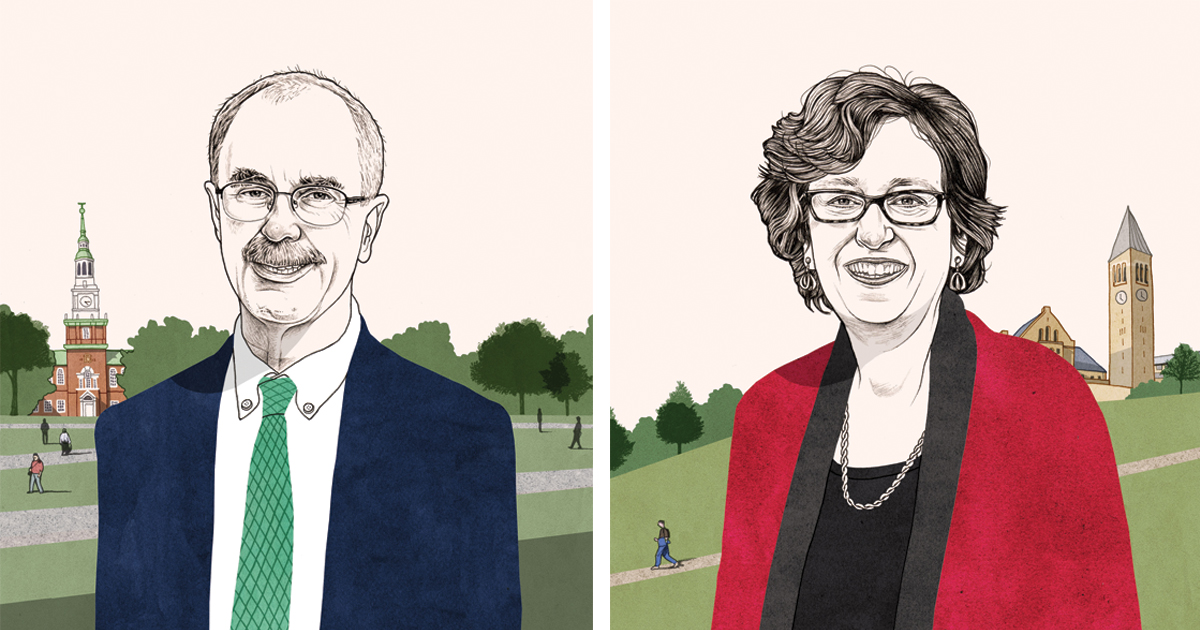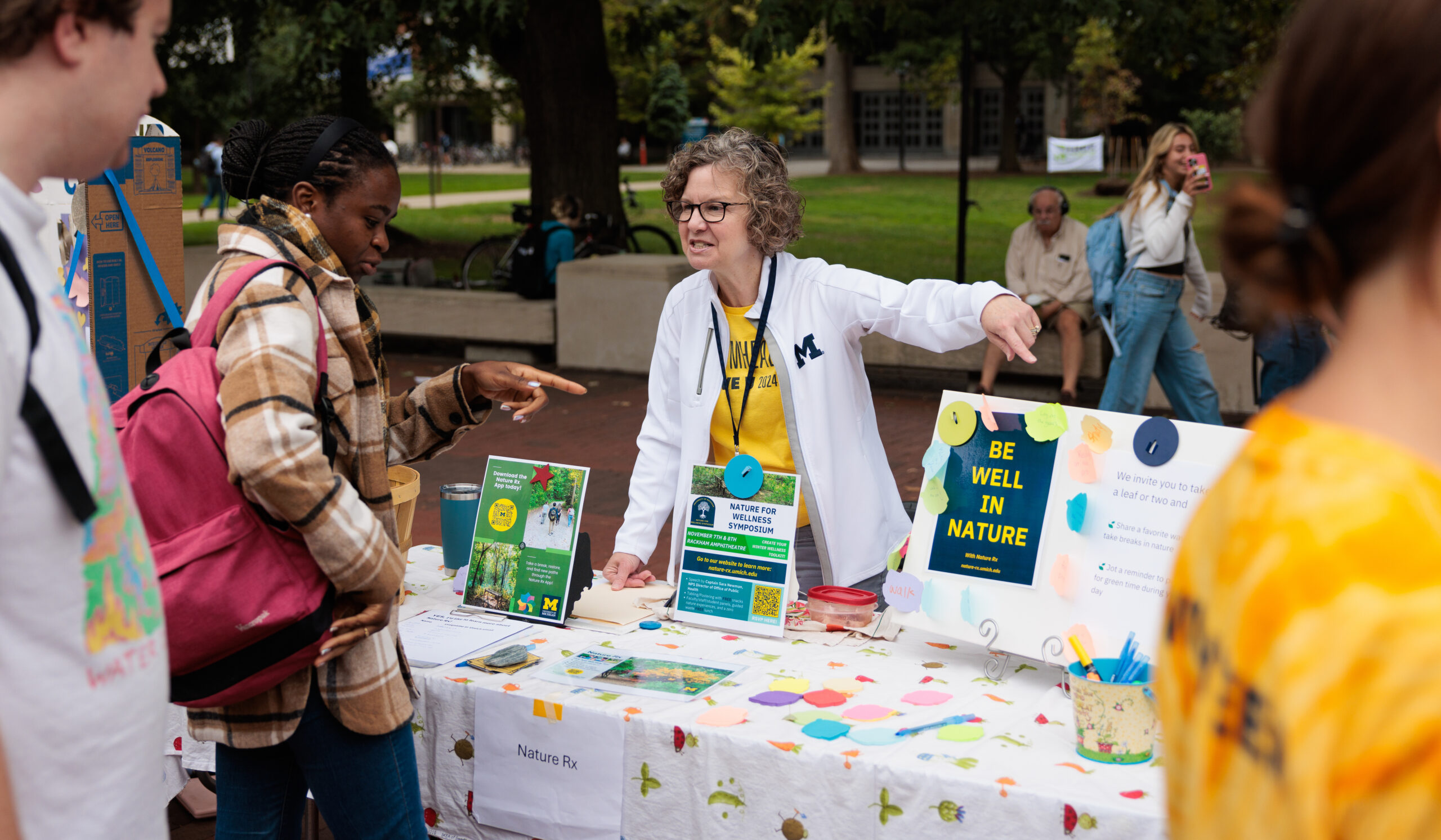In the last three decades, U-M’s campus has become a training ground for elite college presidents, with Michigan provosts taking lessons of leadership to other institutions of higher learning.
In 2001, U-M mathematics professor Philip Hanlon was given his pick of associate dean positions within the College of LSA. “I chose planning and finance,” he says, thinking his knowledge of numbers would best suit that job, even though, he admits, “I had never seen a budget in my life.”
Less than a decade later, Hanlon was the new provost and executive vice president for academic affairs at U-M. The provost—second only to the president—oversees the University’s academic and budgetary affairs, which today means managing revenues of more than $8 billion. Hanlon’s two-year tenure as provost was such a success that, in 2013, he became president of his undergraduate alma mater, Dartmouth College.
“Once you’re provost at a place like Michigan, all the presidential searches start knocking on your door,” says Hanlon. “Michigan is one of the best-managed universities in the world.”
Hanlon is in distinguished company. While many may know the names of U-M Wolverines now playing with the NFL, appearing on Broadway, or running Fortune 500 companies, there is another arena where the University has groomed some of the country’s top performers.
Over the past three decades, U-M provosts have regularly gone on to become the presidents of a wide variety of universities across the country. These include elite universities like Dartmouth College, Cornell University, the University of Virginia, and Princeton University, where current and past presidents are former U-M provosts.

Philip Hanlon
Indeed, the job is daunting. Not only is the provost the chief academic officer of the University—working with the president to set overall academic priorities and finding the funds for those initiatives—he or she is also the most important assistant to the president, acting as a liaison between faculty and staff.
“Being provost is in many ways the best job at the University,” says Teresa Sullivan, president of the University of Virginia and U-M’s provost from 2006 to 2010. “If you’ve come up the ranks as an academic, you get to see the whole panoply of what’s going on.”
Direct reports to the provost include the deans of all 19 schools and colleges, a myriad of vice provosts, directors, and associate vice presidents as well as the chief information officer. Other offices and entities under the provost’s umbrella include undergraduate admissions, financial aid, the registrar, budget and planning, and even Nichols Arboretum and the U-M Museum of Art. In other words, the provost must make decisions on everything from curriculum to construction.
The good news, according to Paul Courant—U-M’s provost from 2002 to 2005 and the acting provost between Hanlon’s departure and the appointment of the current provost, Martin Philbert, in 2017—is that “nobody wants to make an enemy of the provost.”
Martha Pollack—who last year became president of Cornell University after previously serving as U-M’s provost for three years—cites the size and scope of U-M as an invaluable training tool. “The experience of managing complexity is a reason why the board told me they hired me at Cornell,” Pollack says. “Both U-M and Cornell are complicated universities with many schools and colleges embedded within them. Every day, I think I draw on Michigan.”

Martha Pollack
What is the upward path to becoming a provost? Hanlon says there really isn’t one. He was purely an academic until halfway through his 27-year career at U-M.
“The interesting thing about academic institutions is that there is no agreed-upon path to leadership. There are opportunities that arise, and you take them if you are interested and see where they lead. Sometimes they work out, and sometimes they don’t,” he says.
After 3 1/2 years as an associate dean, Hanlon planned to return to teaching when then-provost Courant asked him to become vice provost for finance. “It was a tremendous learning opportunity,” says Hanlon, who dealt with everything from benefits to facilities. “I’m really a student at heart. I love to learn things.”
After six years in the vice provost position, Hanlon was considering leaving U-M for a provost position at another school when Sullivan announced her departure for Virginia in 2010. Then-UM President Mary Sue Coleman and members of the board of regents talked Hanlon into staying and replacing Sullivan as U-M’s next provost.
For Hanlon, the challenge could not have been bigger. State funding was declining—it fell $177 million during his nine years as a vice provost and provost. Across campus, facilities were crumbling, U-M lagged behind other schools in offering undergraduate and graduate specialties, and faculty were departing.

Teresa Sullivan
Hanlon addressed every issue, creating a $45 million annual fund for building renovations and launching a faculty hiring initiative that emphasized diversity.
He planned to remain at U-M, but two years into his time as provost, Dartmouth called. “I had said ‘no’ to everybody else, but this was special,” Hanlon says of accepting the offer from his alma mater.
Hanlon credits the “constant mentorship” of Coleman while he was provost for teaching him about the president’s role. “I was close enough to her as president that I don’t think there’s anything here (at Dartmouth) that’s been really surprising,” he says.
Former U-M provosts do agree, however, that being the president of an institution of higher learning is a far more visible job than being one of its top administrators. Like U-M President Mark Schlissel, Hanlon is a celebrity on the Dartmouth campus, set in a remote area of New Hampshire across the border from Vermont. Yet with a student body a fraction of the size of U-M (4,000 undergraduates and 2,100 graduate students), a strong presence in the community is expected. “People want to have access to the president, they want to see the president, they want me to be at sporting events, at theater and musical events,”
says Hanlon.
In fact, the Dartmouth trustees were most worried about whether he and his wife, Gail, would be able to handle the scrutiny. “Do you know what it’s like to be under a microscope like this?” the trustees asked him. Hanlon replied, “Absolutely. It does mean that when difficult issues erupt and passions are high, you’re going to have to confront them directly.”
It is hard to think of another university president who has endured more crises than Sullivan, the first female president of Virginia. She had a fight with her board over cost cuts two years into her tenure in 2012 that led to her brief resignation before public outcry prompted her to be reinstated. Then the campus was rocked by an article in Rolling Stone magazine, later discredited, that alleged sexual misconduct by fraternity members.
But the ultimate challenge might have been in August 2017, when Virginia’s campus was overrun by white nationalists and neo-Nazi protestors, led by Richard Spencer, the head of a white-supremacist think tank. The accompanying violence led to the death of a young protester and dozens of injuries.
“That wasn’t an experience we’d ever had before,” says Sullivan, who is stepping down from the presidency in September 2018. “We hadn’t reviewed our policies and procedures since the Vietnam War era.”
A key factor for both provosts and presidents to remember, according to Harold Shapiro—president emeritus of Princeton University and U-M’s president from 1980 to 1988—is that you can recover from mistakes. “You get a place as strong as Michigan, nobody can sink it,” explains Shapiro, who was vice president for academic affairs at U-M from 1977 to 1980. (Three years later, the word “provost” was added to that job title.) “These places are too big and too strong and too resilient. All you can do is try to move it ahead a little.”
Cornell’s Pollack says both positions require a big-picture approach. “The people I have known who have been the most successful leaders have made it a point to make sure their leadership is not about them,” she says. “You have to care about the people around you.”
Hanlon echoes that remark. “Michigan administrators look at the values and the institution’s success, not just their personal success. I had a wonderful time at U-M. It’s a great, very fulfilling life.”
U-M Paths to the Presidency
Below is a list of other former U-M administrators and provosts who are currently presidents of U.S. universities.
Dennis Assanis
President of the University of Delaware
2016-present
Rebecca Blank
Chancellor of the University of Wisconsin
2013-present
Lee Bollinger
President of Columbia University
2002-present
Nancy Cantor, HLLD’11
Chancellor of Rutgers University/Newark
2014-present
Farnam Jahanian
President of Carnegie Mellon University
Appointed March 2018
David Munson Jr.
President of the Rochester Institute of Technology
Appointed July 2017
Micheline Maynard, a Knight-Wallace fellow at U-M in 1999-2000, is a regular contributor to Michigan Alumnus.





